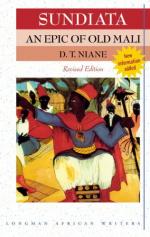|
This section contains 10,280 words (approx. 35 pages at 300 words per page) |

|
SOURCE: Bulman, Stephen. “The Buffalo-Woman Tale: Political Imperatives and Narrative Constraints in the Sunjata Epic.” In Discourse and Its Disguises: The Interpretation of African Oral Texts, pp. 171-207. Birmingham, Ala.: Centre of Western African Studies, 1989.
In the following essay, Bulman analyzes how the storyteller achieves new meaning by reworking the hunter-stranger motif in the Sunjata.
The Sunjata epic has achieved considerable prominence among the oral art compositions of West Africa since Niane's publication of a prose reconstruction in French in 1960. Other versions more faithful to the style of jeli (griot or bard) have since appeared in some numbers, most notably a rendition by Kèlè Mònsòn Jabatè—which has been published in three different forms (Diabaté 1970 and 1975; Moser 1984)—three recitations from the Gambia (Innes 1974) and two from Kita (Johnson 1979 and 1986). Interpretative work upon the epic (primarily as folklore) and its context has also appeared in Bird...
|
This section contains 10,280 words (approx. 35 pages at 300 words per page) |

|


